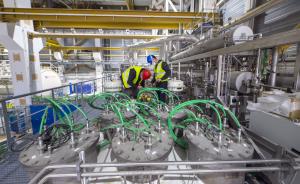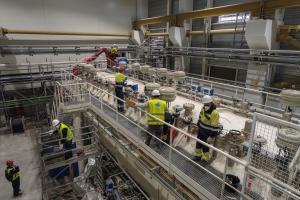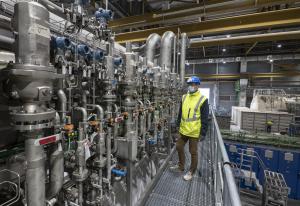Cryodistribution
Blowing cold and hot
23 Nov 2020
If the cryodistribution system were a railroad, the cryogenic termination cold box would be its main switch. A massive structure packed with pipes, valves, electrical feedthroughs and pneumatic actuators, the termination cold box collects the cooling fluids from the cryoplant and redirects them to the Tokamak Building over an elevated bridge. Once inside the building, another set of smaller cold boxes, called "auxiliary" boxes, dispatches the fluids to their different clients— supercritical helium at 4.7 K to the magnets and cryopumps, gaseous helium at 80 K to the thermal shield.
ITER technical responsible officer Hyun Sik Chang (right) and a technician from the Swiss company Linde Kryotechnik AG, perform the cleanliness check protocol on the box's multiprocess cryolines.
During operation, the ITER superconducting magnet system (all 10,000 tonnes of it), the cryopumps and the thermal shield must be kept at cryogenic temperature. But when maintenance is scheduled, this huge mass of frigid components must be brought back up to room temperature.
"Because of the considerable mass of the superconducting magnets, and of the quality of the machine's vacuum insulation, it would take several weeks for the ultra-cold components to warm up and allow maintenance," explains David Grillot, the head of ITER Cryogenic System Section. Hence the second mission of the cryogenic termination cold box: to bring the magnets and their environment to room temperature.
Procured by ITER India and manufactured by the Swiss company Linde Kryotechnik AG, the cryogenic termination cold box is a massive structure packed with pipes, valves, electrical feedthroughs and pneumatic actuators.
Magnets are maintained at cryogenic temperature by a constant flow of supercritical helium (neither liquid nor gaseous, but a bit of both) from the cryoplant systems. When the time comes to warm up the machine, the cooling fluid from the cryoplant is diverted to a parallel circuit that takes it through a set of powerful electrical heaters before being blown into the magnets.
"Let's say that instead of continuing to blow very cold, we blow warmer and warmer, with small increments on the order of one degree per hour in order to prevent mechanical constraints," says Grillot. "Progressively, over the course of a few days, the magnets' temperature rises from that of a winter night on Pluto to that of a balmy spring day in Provence, and the machine become accessible for maintenance operations."
Bringing the temperature inside the machine from that of a winter night on Pluto to that of a balmy spring day in Provence. Pictured: David Grillot, the head of ITER Cryogenic System Section.
Procured by ITER India, the cryogenic termination cold box is manufactured by the Swiss company Linde Kryotechnik AG. Installation in the cryoplant began in early July and should be completed by the end of this month.




